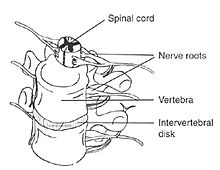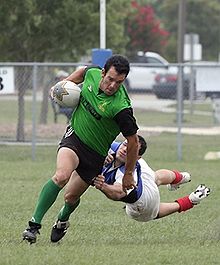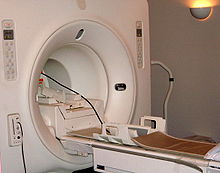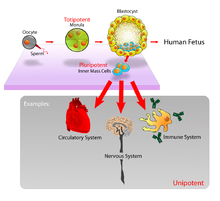- Myelomalacia
-
MRI image shows spinal bleeding (myelomalacia).

Myelomalacia is a pathological term referring the softening of the spinal cord.[1] Hemorrhagic infarction (bleeding) of the spinal cord can occur as a sequel to acute injury, such as that caused by intervertebral disc extrusion (being forced or pressed out).[2]
The disorder causes flaccid paraplegia (impairment of motor function in lower extremities), total areflexia (below normal or absence of reflexes) of the pelvic limbs and anus, loss of deep pain perception caudal (in a direction toward the coccyx [tail]) to the site of spinal cord injury, muscular atrophy (wasting away of muscle tissue), depressed mental state, and respiratory difficulty due to intercostal (muscles that run between the ribs) and diaphragmatic paralysis.[3] Gradual cranial migration of the neurological deficits (problems relating to the nervous system), is known as ascending syndrome and is said to be a typical feature of diffuse myelomalacia. Although clinical signs of myelomalacia are observed within the onset (start) of paraplegia, sometimes they may become evident only in the post-operative period, or even days after the onset of paraplegia. Death from myelomalacia may occur as a result of respiratory paralysis when the ascending lesion (abnormal damaged tissue) reaches the motor nuclei of the phrenic nerves (nerves between the C3-C5 region of the spine) in the cervical (neck) region.[4]
Contents
Classification
Myelomalacia effects the neurological functions in the spinal cord. Once breached, the ramification of the damage directly affects the motor functions of the body. Because the central nervous system of affected, the condition is classified under the neurological field of study.[citation needed]
Spinal Cord Injury
When myelomalacia occurs, the damage done to the spinal cord may range from minimal to extensive. The spinal cord and the brain work together, making them the key components of the central nervous system.[5] Damage to this system affects specific functions of the body, primarily relating to the function of muscles. The areas most commonly injured include the cervical vertebrae (C1-C7), and the lumbar spine (L1-L5).[6]
Symptoms
The onset of myelomalacia may be so subtle that it is overlooked. Depending on the extent of the spinal cord injury, the symptoms may vary.[7] In some cases, the symptom may be as common as hypertension. Though every case is different, several cases reported loss of motor functions in the extremities, areflexia or sudden jerks of the limbs, loss of pain perception, or even paralysis; all of which are possible indicators of a damaged and softened spinal cord.[7] In the most severe cases, paralysis of the respiratory system manifests in death.[citation needed]
Cause
The most common way the disorder occurs is from a result of hemorrhaging (bleeding within) or inadequate blood supply to the spinal cord, making it weak and susceptible to damage.[citation needed]
Because myelomalacia involves a damaged spinal cord, it may occur in any individual. Those most at risk are the geriatric population due to weaker bone density. Once the spinal injury has occurred, one of two things may happen. Firstly, hemorrhaging within the spinal cord may cause compression, which damages the spinal cord even further. Another consequence of myelomalacia is improper circulation of blood to the area damaged, resulting in further to the spinal cord.[citation needed]
Sport Athletes
Due to extensive physical contact and activity, many athletes become victim to myelomalacia.[1] Any accidents or injuries attained during athletic competition to the spinal cord may result in myelomalacia. Accounts of awkward landing on the ground or being hit intensively have attested to spinal cord injury.[citation needed]
Geriatric
With the growth in the elderly population of humans, there has been a rise to myelomalacia. Because the human body begins to deteriorate with age, and because human population is living many years longer, there has been a growth in cases of myelomalacia. As the bones in the body begin to weaken in a process known as osteopenia, the body is more vulnerable to damage. A simple fall may trigger damage to the myelomalacia and spinal cord damage may soon ensue.[citation needed]
Diagnosing
There are two tests that can provide a definite diagnosis of myelomalacia; magnetic resonance imaging (MRI), or myelography. Magnetic resonance imaging (MRI) is a medical imaging technique used in radiology to visualize the internal structure of the body used in the diagnosing of myelomalacia.[8] Certain MRI findings can detect where bone density and matter has been lost in people with spinal cord injuries. Another common test performed in spinal cord injuries is the myelography. A myelography is a specific type of radiographic examination that uses contrast medium to detect pathology of the spinal cord, including the location of spinal cord injury, cysts, and tumors. This examination is used to find the cause of pain not found in an MRI test.[citation needed]
Treatment
There is no known cure for nerve damage due to myelomalacia. Once damaged, the nervous system will not respond to any treatment, but there is a possibility for the condition to worsen. Because motor functions are affected, development of tightening and whithering muscles will occur. The option of surgery is implicated to stop further damage from compression of occurring, though damage already attained may not be cured as of yet. Other medical options to consider may include the use of steroids to reduce the swelling of the spinal cord, reduce the amount of pain, or decrease the tightness of the muscles (spasticity).[citation needed]
Stem Cell Research
The demand for treatments on diseases has sparked a controversy among those involved with stem cell research. Since stem cells have the ability to differentiate into any type of cell, they offer something in the development of medical treatments for a wide range of conditions. Treatments that have been proposed include treatment for physical trauma, degenerative conditions, and genetic diseases (in combination with gene therapy).[9] The hope for a treatment for myelomalacia lies in the hands of stem cell research. Further treatments using stem cells could potentially be developed thanks to their ability to repair extensive tissue damage. Much success and potential has been demonstrated from research using adult stem cells. There are no approved treatments or human trials using embryonic stem cells. Nevertheless, some researchers are of the opinion that the differentiation potential of embryonic stem cells is broader than most adult stem cells. Embryonic stem cells can become all cell types of the body because they are Totipotent. Adult stem cells are generally limited to differentiating into different cell types of their tissue of origin.[citation needed]
However, some evidence suggests that adult stem cell plasticity may exist, increasing the number of cell types a given adult stem cell can become. In addition, embryonic stem cells are considered more useful for nervous system therapies, because researchers have struggled to identify and isolate from adult tissues. Embryonic stem cells, however, might be rejected by the immune system - a problem which wouldn't occur if the patient received his or her own stem cells.[9] Medical scientists believe that these stem cell therapies have the ability to change the treatment of human diseases tremendously. Stem cell therapies are currently being conducted in patients with bone marrow transplants, used to treat leukemia. The future use of this treatment looks to be able to treat diseases such as cancer, spinal cord injury, Lou Gehrig's disease, multiple sclerosis, and a number of other muscular conditions.[9]
Stem Cell Controversy
Stem cell research has the potential to cure many diseases, though much skepticism surrounds the issue. Those opposed to stem cell research concordantly agree on the primary basis that the research is unethical. Currently, technology allows for the destruction of the human embryo and/or therapeutic cloning of the cells, therefore enabling eyebrows to be raised, although recent research has shown the ability to manipulate adult stem cells into embryonic like cells which can serve with the same purpose.[10] Both scientists and those opposing stem cell research may soon agree on the use of adult stem cells, rather than embryonic stem cells.[citation needed]
See also
References
- ^ a b Platt, Simon R.; McConnell, J. Fraser; Bestbier, Mark (2006). "Magnetic Resonance Imaging Characteristics of Ascending Hemorrhagic Myelomalacia in a Dog". Veterinary Radiology & Ultrasound 47: 326–30. doi:10.1111/j.1740-8261.2005.00109.x.
- ^ Quencer, Robert M.; Sheldon, Jerome J.; Post, M. Judith Donovan; Diaz, Rosendo D.; Montalvo, Berta M.; Green, Barth A.; Green, FJ; Eismont, Frank J. (1986). "MRI of the Chronically Injured Cervical Spinal Cord". American Journal of Roentgenology 147 (1): 125–32. PMID 3487204. http://www.ajronline.org/cgi/pmidlookup?view=long&pmid=3487204.
- ^ McMinn, P.; Stratov, I.; Nagarajan, L.; Davis, S. (2001). "Neurological Manifestations of Enterovirus 71 Infection in Children during an Outbreak of Hand, Foot, and Mouth Disease in Western Australia". Clinical Infectious Diseases 32 (2): 236–242. doi:10.1086/318454. JSTOR 4482452. PMID 11170913.
- ^ Langdon, F. W. (1994). "Myelomalacia, With Especial Reference To Diagnosis and Treatment". The Journal of Nervous and Mental Disease 32 (5): 233–44. http://books.google.com/books?id=mGIDAAAAYAAJ&pg=PA233.
- ^ Dubreuil, C. I.; Winton, M. J.; McKerracher, L. (2003). "Rho Activation Patterns after spinal Cord Injury and the Role of Activated Rho in Apoptosis in the Central Nervous System". The Journal of Cell Biology 162 (2): 233–243. doi:10.1083/jcb.200301080. JSTOR 1621683. PMC 2172802. PMID 12860969. http://www.pubmedcentral.nih.gov/articlerender.fcgi?tool=pmcentrez&artid=2172802.
- ^ Anderson, M. J. (1993). "Differences in Growth of Neurons from Normal and Regenerated Teleost spinal Cord in vitro". In Vitro Cellular 29A (2): 145–152. JSTOR 4296977.
- ^ a b Potter, K; Saifuddin, A (2003). "MRI of chronic spinal cord injury". British Journal of Radiology 76 (905): 347–52. doi:10.1259/bjr/11881183. PMID 12763953.
- ^ Jackson, RP; Becker, GJ; Jacobs, RR; Montesano, PX; Cooper, BR; McManus, GE (1989). "The neuroradiographic diagnosis of lumbar herniated nucleus pulposus: I. A comparison of computed tomography (CT), myelography, CT-myelography, discography, and CT-discography". Spine 14 (12): 1356–61. PMID 2694388.
- ^ a b c Prusa, AR; Marton, E; Rosner, M; Bernaschek, G; Hengstschläger, M (2003). "Oct-4-expressing cells in human amniotic fluid: A new source for stem cell research?". Human reproduction 18 (7): 1489–93. doi:10.1093/humrep/deg279. PMID 12832377.
- ^ Heng, B. C.; Liu, H.; Cao, T. (2004). "Feeder Cell Density: A Key Parameter in Human Embryonic Stem Cell Culture". In Vitro Cellular 40 (8): 255–257. doi:10.1290/0407052.1. JSTOR 4295560.
Categories:- Neurological disorders
Wikimedia Foundation. 2010.




